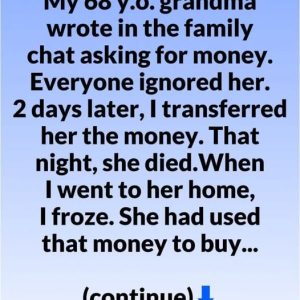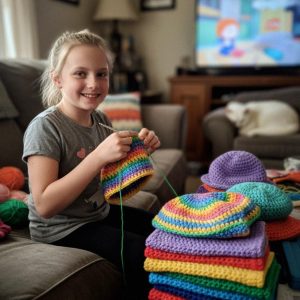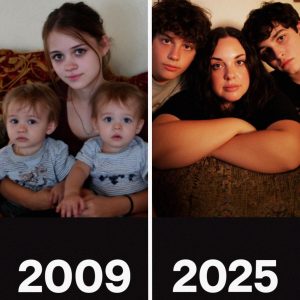Paragraph 1:
On a storm‑soaked night, everything Hannah thought she had put behind her returns when her sister Megan appears at the door gripping both a child’s hand and a manila envelope. Inside the house, with rain still pounding outside, the truth unfolds through DNA results and official paperwork: the little girl, Ava, whom Megan and her husband believed they were fostering, is actually Hannah’s biological daughter. The revelation rips open a chapter of Hannah’s past she has spent six years trying not to revisit — her unexpected pregnancy at twenty‑two, the father’s rejection, the shame and fear that led her to choose adoption, and the agonizing four hours she spent holding her newborn before signing away her parental rights. She believed she had done the responsible thing, protecting her baby from instability, but now learns the adoptive couple lost custody due to neglect and that Ava has been in foster care ever since.
Paragraph 2:
Shattered by the news, Hannah grapples with overwhelming guilt and disbelief, insisting she had tried to save her daughter, not abandon her. Megan reassures her, making clear that the system and the adoptive parents failed, not Hannah. Meanwhile, Hannah watches Ava — quiet, gentle, observant — and feels the word daughter settle heavily but irrevocably in her chest. Megan urges her to speak with Lewis, Hannah’s partner, and promises unwavering support if she chooses to pursue involvement in Ava’s life. That night, Hannah confesses everything to Lewis: the affair, the lost job, the pregnancy, the adoption she has never stopped mourning. Though Hannah fears judgment, Lewis responds with compassion, telling her this might be their chance to do something truly good. He insists she didn’t fail her child — she was alone then, but will not be alone now.
Paragraph 3:
What follows is a difficult, emotionally draining journey through courts, agencies, and the foster system. Months are filled with interviews, inspections, background checks, and home studies that measure the adequacy of Hannah and Lewis’s home down to their pantry organization. A social worker challenges Hannah directly, asking why this time should be different. Hannah answers with vulnerability: she is not the frightened twenty‑two‑year‑old she once was; she has stability, support, and an entire six years of regret urging her forward. Megan becomes a relentless advocate — writing letters, calling judges, pushing through bureaucratic barriers, and refusing to let Hannah face any step alone. Her advocacy takes a toll on her, yet she continues with fierce loyalty, determined to reunite her sister and niece.
Paragraph 4:
At last, on a cold morning in March, a judge signs the order granting Hannah custody. Ava moves in, carrying hesitation like a shield. She behaves with the cautious politeness of a guest who does not want to be a burden. Slowly, Hannah and Lewis work to help her feel at home, letting her choose her room’s sunset‑pink paint, discovering her love of strawberry pancakes, and giving her all the gentleness she has lacked. Ava sleeps clutching a stuffed giraffe and calls them by their first names, an emotional distance Hannah understands and accepts. Over time, trust builds in small, patient steps. Then, during a quiet April evening on the porch, Hannah finally tells Ava the truth: she is her biological mother, she loved her since birth, and she made a decision she thought was best but has regretted ever since. Ava listens solemnly, then climbs into Hannah’s lap and says she knew her mother would come back.
Paragraph 5:
Life gradually reshapes itself around this new, healing family. Six months later, their days are filled with ordinary routines that feel extraordinary to Hannah — cereal breakfasts, school hair braids, stories repeated nightly, and Ava’s animated retellings of classroom adventures. Weekends bring family dinners with Megan, whom Ava now calls “Aunt Meg,” and laughter that fills the spaces once occupied by grief. The household becomes a place stitched together by second chances, resilience, and love that grows steadier with time. Hannah often watches Ava and Megan drawing together at the kitchen table, struck by how easily this could have turned out differently. A sealed file and a lie might have kept them strangers forever, but instead, her sister’s persistence returned Hannah’s daughter to her.
Paragraph 6:
With each passing day, Hannah reflects on how impossibly narrow the path was that led them back to one another — how one mail-in DNA test opened a door she once believed closed forever. She doesn’t take a moment of it for granted. She tells Ava, over and over, that she is wanted, chosen, and home. She acknowledges her past mistake honestly but promises never to walk away again. The story becomes one not of shame, but of redemption: the transformative power of love, the courage to confront the past, and the remarkable grace of a second chance. Some chapters, Hannah realizes, don’t end — they wait in the dark for the right moment, the right hand, the right love to reopen them. And now, finally, she gets to write the ending her daughter — and she herself — always deserved.





